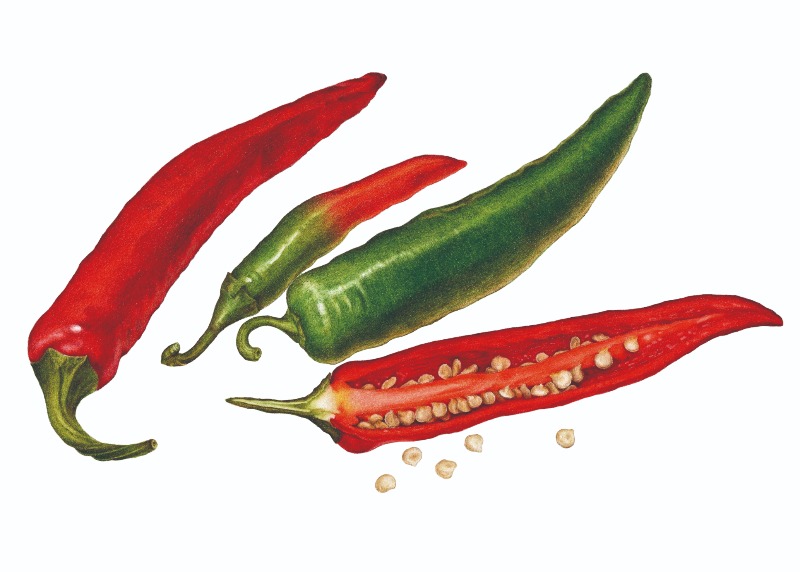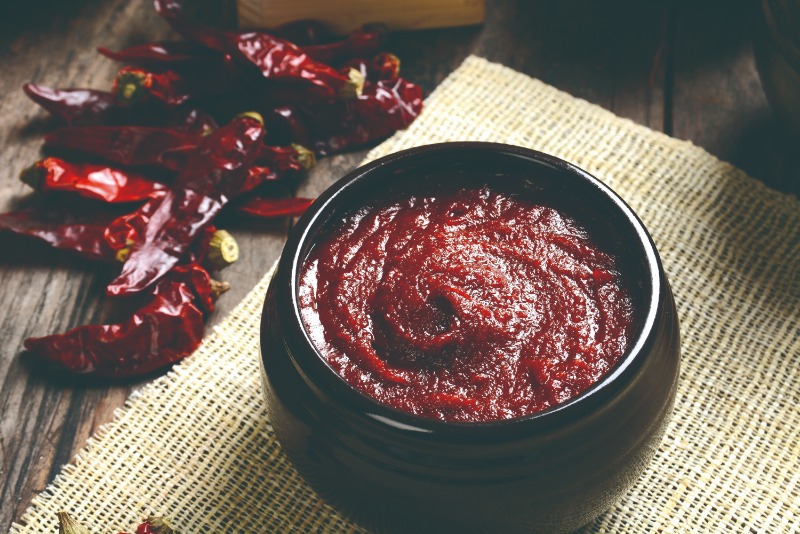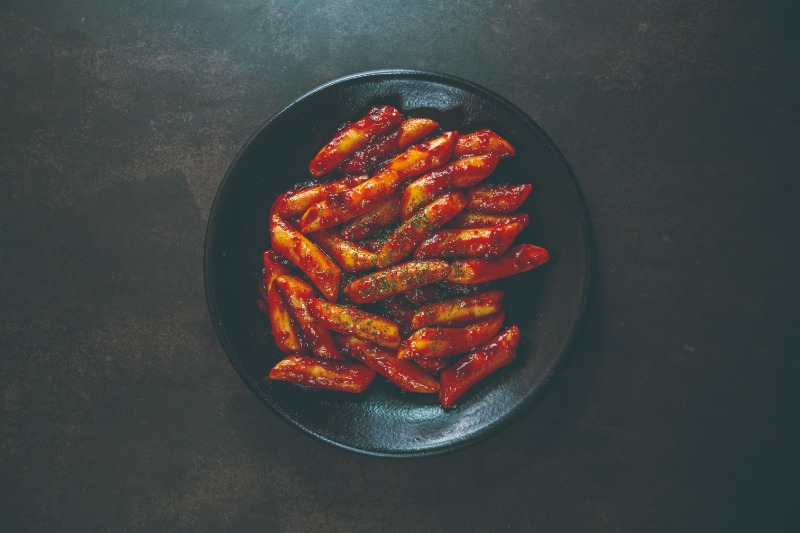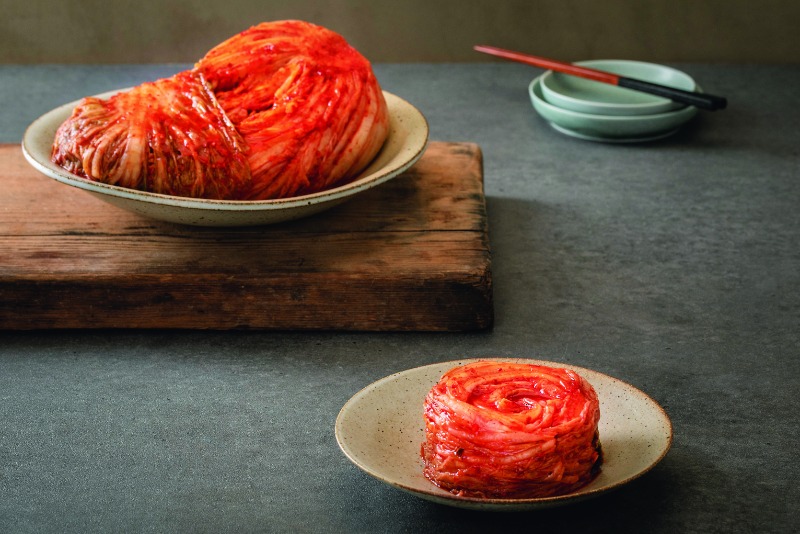Chili, the most widely cultivated spice in the world today, is enjoyed by a quarter of the world’s population. In Korea, the chili pepper (or red pepper) called gochu is an especially important ingredient in the hot and spicy food that Koreans love.

Chili is central to Korean cuisine. It is so essential that its spicy taste seems made for Koreans.
Chili is the most widely cultivated spice in the world today. Chili peppers originated in South America, where people first ate them around 7,000 BCE and began cultivating them around 3,500 BCE. After spreading to Europe at the end of the 15th century, they were introduced to India, Asia and Africa through Portuguese merchants in the latter half of the 16th century. It was around this time that chili was introduced to Korea as well. When chili production later increased in Asia, it was exported back to Europe.
The Measure of Heat
Chilies are the symbol of spiciness. One major indicator of this spiciness, or “heat,” is the Scoville scale, developed in 1912 by American pharmacist Wilbur Scoville. Today, there are other, more accurate ways of measuring capsaicin, the pungent component in chili, but the Scoville scale is still widely used. Pure capsaicin has 16 million SHUs (Scoville heat units). SHUs indicate how much a pepper needs to be diluted for its spiciness to become undetectable. The higher the SHU, the hotter the pepper.
Some peppers, such as green bell peppers, aren’t hot at all, but once the scale reaches jalapenos (2,500 to 10,000 SHUs), which are often pickled, the taste is moderately spicy. In the past, the habanero (350,000 to 580,000 SHUs) was considered a pretty hot pepper, but new and even spicier varieties have since been developed, including the bhut jolokia (or “ghost pepper” at 855,000 to 1.5 million SHUs) and the Trinidad Moruga scorpion (1.5 to 2 million SHUs). Of course, there are people who enjoy eating these extremely hot chili peppers, even as others struggle with them.
Interestingly, chili peppers pose no problem for birds – they lack the receptors that detect the heat of capsaicin. Birds do not digest the seeds and therefore play a role in spreading them after eating chili. On the other hand, there is a theory that the capsaicin in chili peppers is meant to prevent mammals such as humans from eating them, and it’s true that rodents such as squirrels avoid them after a single taste.
Fiery Pleasure

Red pepper paste (gochujang) is a traditional Korean seasoning made by mixing glutinous rice with red pepper powder, malt and fermented soybean powder.
© gettyimagesKOREA
Certain people enjoy the hot taste of chili peppers so much that they even compete in chili eating contests. This is because the heat, or pungency, of chilies provides a pleasure akin to that of a roller coaster, as discovered by Professor David Julius at the University of California, San Francisco, one of the co-winners of the 2021 Nobel Prize in Physiology or Medicine. According to his research, a receptor known as transient receptor potential vanilloid 1 (TRPV1) detects the heat in capsaicin. Simply put, the spicy taste of chili stimulates the sense of heat, creating the illusion of being burned. Enjoying the sensation of falling through the air while on a roller coaster is similar in context to shedding tears while eating a mouthful of chili.
But while the thrill of the roller coaster disappears after it descends, the hot taste of chili lingers in the mouth for a long time, which can be painful. And yet, adding chili extract or capsaicin to a pain relief patch or cream helps relieve muscle or joint pain. This is because repetition of the pain caused by the spicy stimulus depletes the pain-related neurotransmitters of their active agency, and conversely reduces pain.
After consuming spicy, stimulating foods containing pepper, garlic or ginger, your body reacts as if you were in a hot room. You sweat to lower your body temperature and increase blood flow to the skin. As a result, skin temperature drops and you feel cool. This is perhaps why people living in hotter regions tend to enjoy spicy food more, and explains the logic behind Koreans’ predilection for hot, spicy food on a hot summer day. However, the relationship between climate and chili consumption is not necessarily consistent, and opinions are still divided as to why humans like spicy food so much. Chili grows well in warm climates but may be difficult to cultivate in cold countries, perhaps resulting in low production and consumption. Moreover, it isn’t as if people don’t eat spicy food in the winter; in Korea, kimchi is a favorite winter food and a representative spicy staple on the dining table, although its hot taste gradually grows milder as it ferments and matures. The spiciness may be reduced as capsaicin becomes diluted in the kimchi broth, or as it decomposes into a compound that is less hot due to microbial fermentation. In 2015, a research team led by Professor Kim Soo-ki at Konkuk University discovered a microorganism that decomposes capsaicin in pickled red peppers, a traditional fermented Korean food.
Various Uses

Gochujang tteokbokki, made by adding sugar to red pepper paste, appeared during the Korean War and has developed into a popular quick bite with several variations.
© TongRo Images
In their native Latin America, chili peppers are used in a variety of ways. In Mexico, many different types of chili peppers are eaten, and go by different names depending upon whether they are raw or dried. When dried in the sun, certain compounds react with one another tonew flavor substances. Mexican cuisine even has rules as to which chilies should be added to certain foods. For example, guajillo, with its sweet and smoky flavor, produced by drying mirasol peppers in the sun, is used in tamales, enchiladas and salsas. Ancho chilies, which are sun-dried poblano peppers, are used either dry or soaked in water and ground to make mole sauce. When chili is added to a dish, it not only increases the spiciness but also adds complex flavors, including sweet, smoky or fruity notes. And adding ground chili to sauces s a soft, thick texture due to the fiber pectin.
In Korea, the hot taste of red peppers (gochu) is so popular that it is considered the taste of Koreans today. However, not everyone welcomed it in the past. Advocates of Western-style modernization in the 1920s and 1930s argued that consumption of hot foods should be reduced as they were not the foods of an advanced people. The general public thought otherwise, changing recipes in a way that enabled them to enjoy the hot taste even more. It’s through this process that red pepper powder (gochugaru) and sugar entered the picture. Until the 1950s, tteokbokki (stir-fried rice cakes) was not spicy – it was made by stir-frying meatand rice cakes seasoned with soy sauce. Shortly after the Korean War, the red tteokbokki that we know today was d by adding sugar and red pepper paste (gochujang). As spicy tteokbokki began to catch on, the old soy-sauce version was pushed aside. Spicy stir-fried octopus (nakji bokkeum) and spicy stir-fried pork (jeyuk bokkeum) also became popular around the same time and remain favorites today.
Here, we can confirm once again that people like spicy food for the pleasure it gives. Sweetness is a taste that people like from birth and a symbol of pure pleasure. By contrast, spiciness, which offers a more complex pleasure, is a taste acquired as one grows. The sweet and spicy taste of chili and sugar combined is the refreshing taste of youth.
These days, new foods that are not too hot are in favor. Rose tteokbokki is a good example. Capsaicin is soluble in fat, so the heat cannot be completely washed away in water, but the abundant casein protein in dairy products such as cream or mozzarella cheese binds well with fat. This is why drinking milk or eating yogurt after a spicy meal can reduce any related pain. The cream in rose tteokbokki likewise captures capsaicin, mitigating the feeling of heat. For a similar reason, Korean foods such as cheese dakgalbi (spicy stir-fried chicken) and cheese buldak (hot and spicy chicken) are popular in other countries as well. Even people who aren’t used to hot and spicy foods can easily grow to like them.

Kimchi, the iconic Korean side dish, contains generous doses of red pepper powder. The fermented food varies depending on the region, ingredients, and method of preparation.
© TongRo Images
Loved by Everyone
Columbus, who brought chilies to Europe, thought they were related to pepper, hence the name “chili pepper.” However, chilies are the fruit of the solanaceae family of plants and therefore distinct from peppercorns, which are the fruit of pepperaceae vines. While the heat of chili comes from capsaicin, the pungency of pepper comes from piperine.
There is one more important difference between the two: in medieval Europe, pepper was considered a luxury, and the spicier a dish was made by sprinkling it with pepper, the more luxurious it was. In the 17th century, when Europe imported large quantities of pepper, the upper classes began to seek foods with a mild, delicate taste. Their desire to distinguish themselves from the lower classes, who could now put pepper in their dishes, served to completely change their food preferences.
This was not the case with chili. Unlike pepper, which comes from a subtropical plant, chilies grow well in temperate climates. Being easy to grow also means being widely accessible. At one time, the hot taste of chili was looked down on, but since chili was readily available, most Koreans made and ate their favorite hot foods regardless. Chili is the evidence that Korean cuisine today was shaped not by the elite but by the ordinary people.